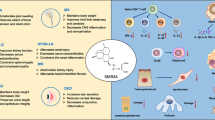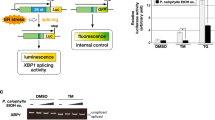Abstract
Febrifugine, the bioactive constituent of one of the 50 fundamental herbs of traditional Chinese medicine, has been characterized for its therapeutic activity, though its molecular target has remained unknown. Febrifugine derivatives have been used to treat malaria, cancer, fibrosis and inflammatory disease. We recently demonstrated that halofuginone (HF), a widely studied derivative of febrifugine, inhibits the development of TH17-driven autoimmunity in a mouse model of multiple sclerosis by activating the amino acid response (AAR) pathway. Here we show that HF binds glutamyl-prolyl-tRNA synthetase (EPRS), inhibiting prolyl-tRNA synthetase activity; this inhibition is reversed by the addition of exogenous proline or EPRS. We further show that inhibition of EPRS underlies the broad bioactivities of this family of natural product derivatives. This work both explains the molecular mechanism of a promising family of therapeutics and highlights the AAR pathway as an important drug target for promoting inflammatory resolution.
This is a preview of subscription content, access via your institution
Access options
Subscribe to this journal
Receive 12 print issues and online access
$259.00 per year
only $21.58 per issue
Buy this article
- Purchase on SpringerLink
- Instant access to full article PDF
Prices may be subject to local taxes which are calculated during checkout






Similar content being viewed by others
References
Clardy, J. & Walsh, C. Lessons from natural molecules. Nature 432, 829–837 (2004).
Howitz, K.T. & Sinclair, D.A. Xenohormesis: sensing the chemical cues of other species. Cell 133, 387–391 (2008).
Coatney, G.R., Cooper, W.C., Culwell, W.B., White, W.C. & Imboden, C.A. Jr. Studies in human malaria. XXV. Trial of febrifugine, an alkaloid obtained from Dichroa febrifuga Lour., against the Chesson strain of Plasmodium vivax. J. Natl. Malar. Soc. 9, 183–186 (1950).
Ryley, J.F. & Betts, M.J. Chemotherapy of chicken coccidiosis. Adv. Pharmacol. Chemother. 11, 221–293 (1973).
Pines, M. & Nagler, A. Halofuginone: a novel antifibrotic therapy. Gen. Pharmacol. 30, 445–450 (1998).
Elkin, M. et al. Inhibition of bladder carcinoma angiogenesis, stromal support, and tumor growth by halofuginone. Cancer Res. 59, 4111–4118 (1999).
McGaha, T. et al. Effect of halofuginone on the development of tight skin (TSK) syndrome. Autoimmunity 35, 277–282 (2002).
Pines, M., Snyder, D., Yarkoni, S. & Nagler, A. Halofuginone to treat fibrosis in chronic graft-versus-host disease and scleroderma. Biol. Blood Marrow Transplant. 9, 417–425 (2003).
Koon, H.B. et al. Phase II AIDS Malignancy Consortium trial of topical halofuginone in AIDS-related Kaposi sarcoma. J. Acquir. Immune Defic. Syndr. 56, 64–68 (2011).
Sundrud, M.S. et al. Halofuginone inhibits TH17 cell differentiation by activating the amino acid starvation response. Science 324, 1334–1338 (2009).
Grohmann, U. & Bronte, V. Control of immune response by amino acid metabolism. Immunol. Rev. 236, 243–264 (2010).
Cobbold, S.P. et al. Infectious tolerance via the consumption of essential amino acids and mTOR signaling. Proc. Natl. Acad. Sci. USA 106, 12055–12060 (2009).
Finlay, D. & Cantrell, D.A. Metabolism, migration and memory in cytotoxic T cells. Nat. Rev. Immunol. 11, 109–117 (2011).
Kilberg, M.S., Pan, Y.X., Chen, H. & Leung-Pineda, V. Nutritional control of gene expression: how mammalian cells respond to amino acid limitation. Annu. Rev. Nutr. 25, 59–85 (2005).
Harding, H.P. et al. An integrated stress response regulates amino acid metabolism and resistance to oxidative stress. Mol. Cell 11, 619–633 (2003).
Harding, H.P. et al. Regulated translation initiation controls stress-induced gene expression in mammalian cells. Mol. Cell 6, 1099–1108 (2000).
Peng, T., Golub, T.R. & Sabatini, D.M. The immunosuppressant rapamycin mimics a starvation-like signal distinct from amino acid and glucose deprivation. Mol. Cell. Biol. 22, 5575–5584 (2002).
Deval, C. et al. Amino acid limitation regulates the expression of genes involved in several specific biological processes through GCN2-dependent and GCN2-independent pathways. FEBS J. 276, 707–718 (2009).
Palii, S.S. et al. Specificity of amino acid regulated gene expression: analysis of genes subjected to either complete or single amino acid deprivation. Amino Acids 37, 79–88 (2009).
Sancak, Y. et al. The Rag GTPases bind raptor and mediate amino acid signaling to mTORC1. Science 320, 1496–1501 (2008).
Zoncu, R., Efeyan, A. & Sabatini, D.M. mTOR: from growth signal integration to cancer, diabetes and ageing. Nat. Rev. Mol. Cell Biol. 12, 21–35 (2011).
Powell, J.D. & Delgoffe, G.M. The mammalian target of rapamycin: linking T cell differentiation, function, and metabolism. Immunity 33, 301–311 (2010).
Hotamisligil, G.S. & Erbay, E. Nutrient sensing and inflammation in metabolic diseases. Nat. Rev. Immunol. 8, 923–934 (2008).
Esposito, M. et al. Rapamycin inhibits relapsing experimental autoimmune encephalomyelitis by both effector and regulatory T cells modulation. J. Neuroimmunol. 220, 52–63 (2010).
Nath, N. et al. Metformin attenuated the autoimmune disease of the central nervous system in animal models of multiple sclerosis. J. Immunol. 182, 8005–8014 (2009).
Kamberov, Y.G., Kim, J., Mazitschek, R., Kuo, W.P. & Whitman, M. Microarray profiling reveals the integrated stress response is activated by halofuginone in mammary epithelial cells. BMC Res. Notes 4, 381 (2011).
Kobayashi, S. et al. Catalytic asymmetric synthesis of antimalarial alkaloids febrifugine and isofebrifugine and their biological activity. J. Org. Chem. 64, 6833–6841 (1999).
Ruan, B. et al. A unique hydrophobic cluster near the active site contributes to differences in borrelidin inhibition among threonyl-tRNA synthetases. J. Biol. Chem. 280, 571–577 (2005).
Copeland, R.A. Evaluation of enzyme inhibitors in drug discovery. A guide for medicinal chemists and pharmacologists. Methods Biochem. Anal. 46, 1–265 (2005).
Kikuchi, H. et al. Potent antimalarial febrifugine analogues against the plasmodium malaria parasite. J. Med. Chem. 45, 2563–2570 (2002).
Heacock, D., Forsyth, C., Shiba, K. & Musier-Forsyth, K. Synthesis and aminoacyl-tRNA synthetase inhibitory activity of prolyl adenylate analogs. Bioorg. Chem. 24, 273–289 (1996).
Splan, K.E., Ignatov, M.E. & Musier-Forsyth, K. Transfer RNA modulates the editing mechanism used by class II prolyl-tRNA synthetase. J. Biol. Chem. 283, 7128–7134 (2008).
Yaremchuk, A., Tukalo, M., Grotli, M. & Cusack, S. A succession of substrate induced conformational changes ensures the amino acid specificity of Thermus thermophilus prolyl-tRNA synthetase: comparison with histidyl-tRNA synthetase. J. Mol. Biol. 309, 989–1002 (2001).
Ibba, M. & Soll, D. Aminoacyl-tRNA synthesis. Annu. Rev. Biochem. 69, 617–650 (2000).
Boye, K. & Maelandsmo, G.M. S100A4 and metastasis: a small actor playing many roles. Am. J. Pathol. 176, 528–535 (2010).
Oslejsková, L. et al. Metastasis-inducing S100A4 protein is associated with the disease activity of rheumatoid arthritis. Rheumatology (Oxford) 48, 1590–1594 (2009).
Pleiss, J.A., Whitworth, G.B., Bergkessel, M. & Guthrie, C. Rapid, transcript-specific changes in splicing in response to environmental stress. Mol. Cell 27, 928–937 (2007).
Mukhopadhyay, R., Jia, J., Arif, A., Ray, P.S. & Fox, P.L. The GAIT system: a gatekeeper of inflammatory gene expression. Trends Biochem. Sci. 34, 324–331 (2009).
Fontana, L., Partridge, L. & Longo, V.D. Extending healthy life span–from yeast to humans. Science 328, 321–326 (2010).
Anderson, R.M. & Weindruch, R. Metabolic reprogramming, caloric restriction and aging. Trends Endocrinol. Metab. 21, 134–141 (2010).
Haigis, M.C. & Yankner, B.A. The aging stress response. Mol. Cell 40, 333–344 (2010).
Caro, P. et al. Effect of 40% restriction of dietary amino acids (except methionine) on mitochondrial oxidative stress and biogenesis, AIF and SIRT1 in rat liver. Biogerontology 10, 579–592 (2009).
Xiao, F. et al. Leucine deprivation increases hepatic insulin sensitivity via GCN2/mTOR/S6K1 and AMPK pathways. Diabetes (2011).
Zelante, T. et al. IL-23 and the Th17 pathway promote inflammation and impair antifungal immune resistance. Eur. J. Immunol. 37, 2695–2706 (2007).
Huang, L., Baban, B., Johnson, B.A. III & Mellor, A.L. Dendritic cells, indoleamine 2,3 dioxygenase and acquired immune privilege. Int. Rev. Immunol. 29, 133–155 (2010).
von Bubnoff, D. et al. Indoleamine 2,3-dioxygenase-expressing myeloid dendritic cells and macrophages in infectious and noninfectious cutaneous granulomas. J. Am. Acad. Dermatol. 65, 819–832 (2011).
Bronte, V. & Zanovello, P. Regulation of immune responses by L-arginine metabolism. Nat. Rev. Immunol. 5, 641–654 (2005).
Plouffe, D. et al. In silico activity profiling reveals the mechanism of action of antimalarials discovered in a high-throughput screen. Proc. Natl. Acad. Sci. USA 105, 9059–9064 (2008).
Ting, S.M., Bogner, P. & Dignam, J.D. Isolation of prolyl-tRNA synthetase as a free form and as a form associated with glutamyl-tRNA synthetase. J. Biol. Chem. 267, 17701–17709 (1992).
Jahn, M.J., Jahn, D., Kumar, A.M. & Soll, D. Mono Q chromatography permits recycling of DNA template and purification of RNA transcripts after T7 RNA polymerase reaction. Nucleic Acids Res. 19, 2786 (1991).
Acknowledgements
The authors would like to thank R. Copeland (Epizyme) for advice on the execution of tight-binding analysis, W. Kuo Harvard Catalyst Laboratory for Innovative Translational Technologies for assistance with the establishment of qPCR assays, and C. Walsh (Harvard), T. Roberts (Dana-Farber Cancer Institute) and S. Thomas (National Institute of Environmental Health Science, USA) for their valuable comments on the manuscript. This work was supported by US National Institutes of Health (NIH) grant GM089885 and a Harvard Technology Accelerator Award (to M.W.); by grants PJ00812701 and PJ008196 from The Next Generation BioGreen 21 Program, Rural Development Administration, Republic of Korea (to C.Y.Y. and H.K.L.); and by NIH grants AI40127 and AI48213 and Juvenile Diabetes Research Foundation 17-2010-421 (to A.R.).
Author information
Authors and Affiliations
Contributions
T.L.K. and M.W. conceived of the idea for the study; designed, directed and interpreted experiments; performed the experiments central to target identification and enzymological characterization; and wrote the manuscript. R.M. conceived of, designed and synthesized critical chemical compounds for use in these studies; performed and interpreted experiments; and helped prepare the manuscript. C.-Y.Y. designed, directed and interpreted experiments performed in Korea; performed and interpreted the experiments involving proline rescue of HF-mediated effects on the AAR pathway and antifibrotic effects; and edited the manuscript. D.Z. performed and interpreted experiments central to EPRS knockdown and HF sensitization as well as proline rescue of HF antifibrotic effects and edited the manuscript. M.S.S. planned and performed the immunology experiments; analyzed and interpreted data; and edited the manuscript. M.H., M.E., J.Y., Y.-J.K. and H.-k.L. performed experiments, M.H. contributed Figure 2c, and J.F.C. carried out the experiment in Supplementary Figure 17. D.F.W. supervised the malaria experiments. J.D.D. provided vital reagents, direction and technical expertise for the EPRS enzyme assays and edited the manuscript. A.R. designed, directed and interpreted the immunology experiments and edited the manuscript.
Corresponding authors
Ethics declarations
Competing interests
T.K., M.W., R.M., M.S. and A.R. have patent applications pending at the US patent office related to the potential therapeutic use of halofuginone and its derivatives.
Supplementary information
Supplementary Text and Figures
Supplementary Methods and Supplementary Results (PDF 2536 kb)
Rights and permissions
About this article
Cite this article
Keller, T., Zocco, D., Sundrud, M. et al. Halofuginone and other febrifugine derivatives inhibit prolyl-tRNA synthetase. Nat Chem Biol 8, 311–317 (2012). https://doi.org/10.1038/nchembio.790
Received:
Accepted:
Published:
Issue Date:
DOI: https://doi.org/10.1038/nchembio.790
This article is cited by
-
Antimalarial drug discovery: progress and approaches
Nature Reviews Drug Discovery (2023)
-
Prolyl-tRNA synthetase as a novel therapeutic target in multiple myeloma
Blood Cancer Journal (2023)
-
Elucidating the path to Plasmodium prolyl-tRNA synthetase inhibitors that overcome halofuginone resistance
Nature Communications (2022)
-
A high-throughput screen for TMPRSS2 expression identifies FDA-approved compounds that can limit SARS-CoV-2 entry
Nature Communications (2021)
-
Effect of the IDO Gene on Pregnancy in Mice with Recurrent Pregnancy Loss
Reproductive Sciences (2021)



